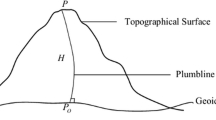Abstract
Errors are introduced in orthometric height computations by the use of standard formulas to estimate mean gravity along the plumb line. Direct measurements of gravity between the Earth’s surface and sea level from bore hole gravimetry were used to determine the magnitude of these errors. For the seven cases studied, errors in orthometric height, due to the use of the Helmert method for computing mean gravity along the plumb line, were generally small (<2 cm). However, in one instance the error was substantial, being9.6 cm. The results verified the general validity of the Poincaré-Prey approach to estimation of gravity along the plumb line and demonstrated that the suggestion byVanicek (1980) that the air gradient is more appropriate is incorrect. With sufficient topographic information to compute terrain corrections, and density estimates from surface gravity, errors in mean gravity along the plumb line should contribute no more than 3cm to orthometric height computation.
Similar content being viewed by others
References
L.A. BEYER (1980): Bore hole gravity program at the U.S. Geological Survey (1963 to 1975)—brief history and basic data, Open file report 80-903, 76 p., U.S. Geological Survey, Denver, Colorado.
L.A. BEYER and F.G. CLUTOM (1978a): Density and porosity of oil reservois and overlying formations from bore hole gravity measurements, Gebo Oil Field, Hot Sorings County, Wyoming, Oil and Gas Investigations Chart OC-88, U.S. Geological Survey Reston, Virginia.
L.A. BEYER and F.G. CLUTSOM (1978b): Bore hole gravity survey in the Dry Piney Oil and Gas field, Big Piney—La Barge area Sublette County, Wyoming, Oil and Gas Investigations Chart OC-84, U.S. Geological Survey, Reston Virginia.
W.A. HEISKANEN and H. MORITZ (1967):Physical Geodesy, 364 p., W. H. Freeman and Company, San Francisco, California.
B.A. KOSOSKI and S.L. ROBBINS (1979): In situ bulk density and porosity estimates from bore hole gravity data in limestones of the Madison Group, Test Well no. 1, Crook County, Wyoming, Open file report 79-1514 12 p., U.S. Geological Survey, Reston, Virginia.
B.A. KOSOSKI, S.L. ROBBINS and J.W. SCHOMOKER (1978a): Principal facts for bore hole gravity stations in stratigraphic test well ERDA No. 9, Eddy County, New Mexico, Open file report 78-696, 12 p., U.S. Geological Survey, Reston, Virginia.
B.A. KOSOSKI, S.L. ROBBINS and J.W. SCHOMOKER (1978b): Principal facts for bore hole gravity stations in test well Ue 19z, exploratory drill hole PM-1, and water well 5a, Nevada Test Site, Nye County, Nevada, Open file report 78-983, 17 p., U.S. Geological Survey, Reston, Virginia.
E.J. KRAKIWSKY (1965): Heights, M.S. Thesis, 157 p., Dept. of Geodetic Science, The Ohio State University, Columbus, Ohio.
K. MADER (1954): Die orthometrische Schwerekorrektion des Prazisions—Nivellements in den Hoken Tauern. Osterreischische Zeitschrift für Vermessungswesen, Sonderheft 15.
J. NEITHAMMER (1932): Nivellement und Schwere als Mittel zur Berechnung wahrer Meereshohen, Schweizerische Geodätische Kommission.
R.R. RAPP (1961): The Orthometric Height, M.S. Thesis, 115 p., Dept. of Geodetic Science, The Ohio State University, Columbus, Ohio.
S.J. ROBBINS, R.J. MARTINEZ, and D.L. SMITH (1979): Principal facts for bore hole gravity stations in wells DC-3, DC-5, and DC-7, at the Hanford Site, Washington and in well RSH no. 1 in Rattlesnake Hills, Washington, Open file report 79 849, 29 p., U.S. Geological Survey, Reston, Virginia.
P. VANICEK (1980): Heights based on observed gravity,in Proceedings, Second International Symposium on Problems Related to the Redefinition of North American Vertical Geodetic Networks, p. 553–566, The Canadian Institute of Surveying, Ottawa, Canada.
Author information
Authors and Affiliations
Rights and permissions
About this article
Cite this article
Strange, W.E. An evaluation of orthometric height accuracy using bore hole gravimetry. Bull. Geodesique 56, 300–311 (1982). https://doi.org/10.1007/BF02525730
Received:
Accepted:
Published:
Issue Date:
DOI: https://doi.org/10.1007/BF02525730




